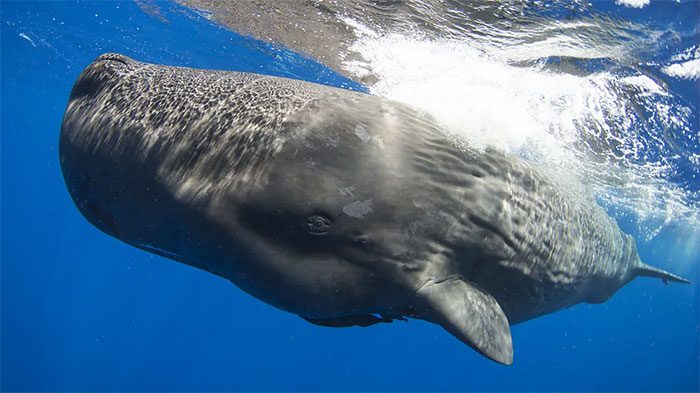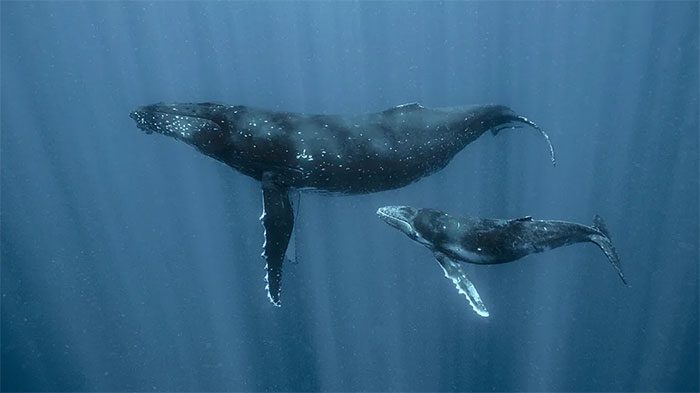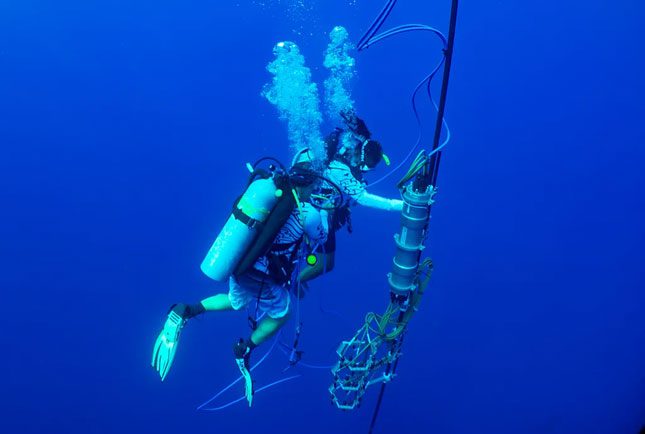For the first time in the world, researchers have had a “conversation” with a whale. Now, their goal is to try to understand what it is really saying.
A rumble emanated from the underwater speaker of the research vessel off the coast of Frederick Sound, Alaska, USA. A humpback whale separated from its pod and approached. It surfaced, then dove again, echoing the call.

A sperm whale.
In 2021, off the Southeast coast of Alaska, a team of six scientists recorded the greeting sounds of a humpback whale using underwater speakers. They were astonished when a humpback whale, named Twain, responded. After their “conversation” with the whale, the researchers noted that this encounter could be the first turning point in communicating with intelligent non-human animals. “It felt like an experience from another world. You hear them surfacing. Then, there’s a loud exhale, and you can see them gathering together. It’s an unbelievable sight,” said Josie Hubbard, an animal behavior researcher.

A humpback whale and its calf.
Ms. Hubbard was on the research vessel when she encountered the humpback whale for the first time. Below deck, acoustician Brenda McCowan was broadcasting a recorded call of a whale through an underwater speaker. Twain “responded,” engaging in a “conversation” that lasted up to 20 minutes.
The haunting and ever-evolving songs of whales can resonate across oceans. They communicate using whistles and pulses, or utilize echolocation to paint pictures of the underwater world. Whales have fascinated humans for centuries, and they exhibit a long list of behaviors similar to ours.
They cooperate with each other as well as with other species. They teach each other useful skills, care for their young, and know how to play. However, unlike humans, the dominant sense of whales is not sight, but hearing. While light fades about 200 meters below the ocean surface, sound can travel farther and faster in water than in air.

Scientists placing microphones underwater to record sperm whale sounds.
Crustaceans have evolved for over 50 million years to produce and perceive a variety of complex sounds. This is how they communicate, navigate, find mates and food, defend their territory and resources, and avoid predators. Their young also babble like human infants, and some seem to have names, with groups from different ocean regions forming their own dialects. Scientists have observed whales mimicking the dialects of other pods, and some individuals are even believed to have attempted to speak human language.
The songs of humpback whales are considered one of the most complex sounds in the animal kingdom. The first recording of a humpback whale song was made in 1952 by U.S. Navy engineer Frank Watlington. Nearly 20 years later, marine biologist Roger Payne noticed that these calls tended to be repetitive. This changed our understanding of how whales vocalize and led to decades of research.
Today, the SETI research team hopes that deciphering whale communication may help us understand extraterrestrials, in case we encounter them. The team hypothesizes that whale sounds contain complex messages, intelligent like human language, or possibly akin to that of aliens. However, McCowan noted that our understanding of how to communicate with whales is still very rudimentary. “We are still at an early stage. A major challenge for us is to classify whale signals and figure out their context, from which we can determine their meaning. I think AI will help us do that,” she said.
More than 8,000 kilometers away from Alaska, a group of natural language processing and artificial intelligence experts, cryptographers, linguists, marine biologists, robotics specialists, and underwater acousticians are also hopeful that AI can decode sperm whale conversations.
Launched in 2020, CETI (Cetacean Translation Initiative), led by marine biologist David Gruber, has been continuously recording a pod of whales off the coast of Dominica, an island in the Caribbean, using microphones attached to buoys, robotic fish, and tags on the whales’ backs.
“Aside from very brief interactions at the surface, it’s hard for us to look into their world. They are unique, gentle, and intelligent creatures. Each time we look back, we find more complexity and depth in their communication,” Gruber said. He believes that with current technological advancements, we have the capability to decode whale communication.
The collected data has been processed using machine learning algorithms to detect and classify calls, and results are expected to be published this year. Gruber stated that the current goal is to recreate a “multi-party conversation.” In other words, to create a dialogue using the very sounds of sperm whales. But even if we could converse with whales, should we? For example, the ability to call whales could be used to hunt them.
New technologies have previously aided hunters. Ultrasound has been used to locate and lure whales to the surface, where they can be more easily shot. This is the dark side.


















































